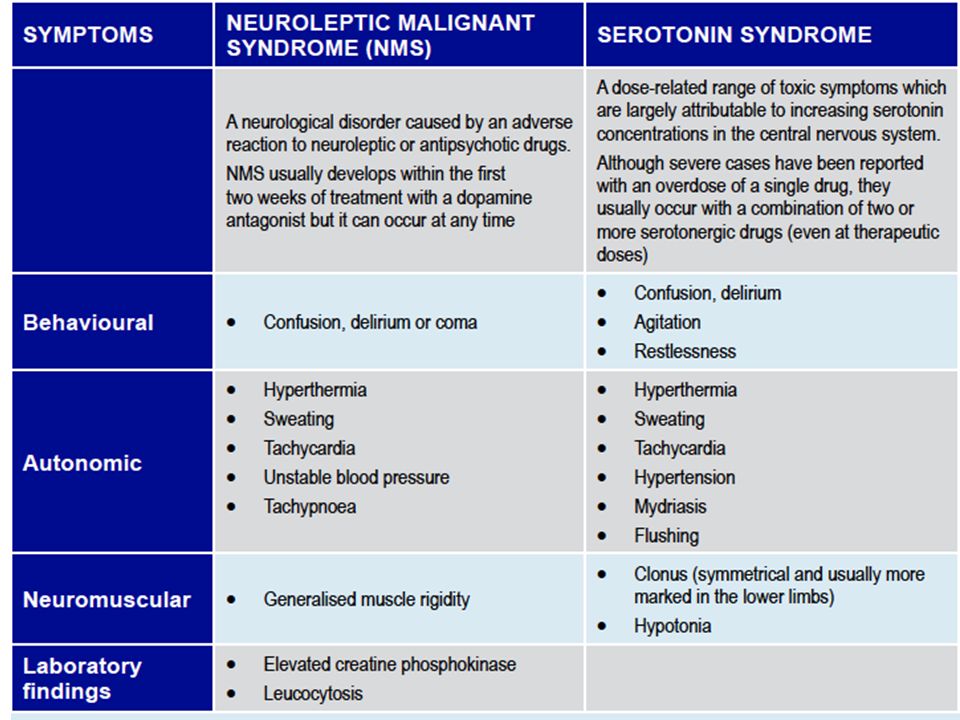Neuroleptic malignant syndrome presents with ≥ 2 of the following cardinal symptoms:
Ss develops over 24 hours, whereas nms develops over a period of days. Fever, altered mental status, muscle rigidity, and autonomic dysfunction. Generally, the first signs are rigid muscles and fever, then drowsiness or confusion. Learn vocabulary, terms, and more with flashcards, games, and other study tools. Some cases presented with features resembling neuroleptic malignant syndrome.

Most people who are susceptible are generally otherwise unaffected when not exposed.
Generally, the first signs are rigid muscles and fever, then drowsiness or confusion. You should maintain high suspicion for these syndromes in any patient with hyperpyrexia. Complications can include muscle breakdown and high blood potassium. Sig e caps (≥ 5 for ≥ 2 weeks) (depressed mood or anhedonia: Video presented by michael ingram, ms, md. Signs include rigidity, temperature, depressed consciousness, and autonomic instability. Picmonic is research proven to increase your memory retention and test scores. Adults + children/adolescents) (irritable mood: Serotonin syndrome and its spectrum of symptoms are a product of the overactivation of both the central and peripheral serotonin receptors as a result. Elevations in ck, lfts, and wbc, coupled with a low iron level, distinguishes nms from serotonin syndrome among. Fever, altered mental status, muscle rigidity, and autonomic dysfunction. This patient has neuroleptic malignant syndrome (nms), which is characterized by altered mental status, muscle rigidity (leading to hyperthermia and rhabdomyolysis), and autonomic instability (tachycardia and hypertension). Serotonin syndrome (ss) and neuroleptic malignant syndrome (nms) are each rare psychiatric emergencies that can lead to fatal outcomes.
Ahuja n, palanichamy n, mackin p, lloyd a. Am j health syst pharm 64 (2007): Elevations in ck, lfts, and wbc, coupled with a low iron level, distinguishes nms from serotonin syndrome among. Preoperative guidelines for medications prior to surgery, preoperative fasting recommendation, nothing by mouth prior to surgery guideline, perioperative npo guidelines, perioperative medication guidelines, medication management in the perioperative period, medications to avoid prior to surgery. Neuroleptic malignant syndrome presents with ≥ 2 of the following cardinal symptoms:

Beginning in may 2020, step 1 examinations will include an.
She reports both seeing colors "coming out of other people's mouths" Symptoms include high fever, confusion, rigid muscles, variable blood pressure, sweating, and fast heart rate. Steinberg m, morin ak "mild serotonin syndrome associated with concurrent linezolid and fluoxetine." The distinguishing features of nms, malignant hyperthermia, and anticholinergic toxicity are listed in table 2. Serotonin syndrome (ss) and neuroleptic malignant syndrome (nms) are each rare psychiatric emergencies that can lead to fatal outcomes. Am j health syst pharm 64 (2007): Their clinical presentations can overlap, which can make it difficult to differentiate between the 2 syndromes; Severe hyperthermia and seizures, sometimes fatal, have been reported in association with the combined use of tricyclic antidepressants and. Quickly memorize the terms, phrases and much more. Fever, rigidity, mental status changes, autonomic instability; Am j psychiatry 164 (2007): Beginning in may 2020, step 1 examinations will include an. Start learning today for free!
Check out this quick usmle sample lesson from medschoolcoach's tutors on neuroleptic malignant syndrome (nms) vs. Serotonin syndrome is a condition characterized by increased serotonergic activity in the central nervous system. Serotonin syndrome is very similar to neuroleptic malignant syndrome. These reactions have also been reported in patients who have recently discontinued that drug and have been started on an maoi. The more recent estimates of the frequency of neuroleptic malignant syndrome indicate an incidence of 0.01% to 0.07% in patients taking antipsychotic drugs.

Most people who are susceptible are generally otherwise unaffected when not exposed.
This occurs when body metabolic heat production or environmental heat. ↓ da in the cns or blockade of d2 receptors in the nigrostriatal pathway: Neuroleptic malignant syndrome (nms) this reaction is rare, but very serious. These contents are covered in questions and answers pool of exam. Agitation, confusion, seizures, hyperthermia peripheral vasomotor stimulation by norepinephrine results in tachycardia and hypertension. malignant hyperthermia (mh) is a type of severe reaction that occurs in response to particular medications used during general anesthesia, among those who are susceptible. The more recent estimates of the frequency of neuroleptic malignant syndrome indicate an incidence of 0.01% to 0.07% in patients taking antipsychotic drugs. Patients present with hyperthermia, extreme generalized rigidity. Adults + children/adolescents) (irritable mood: Some cases presented with features resembling neuroleptic malignant syndrome. Beginning in may 2020, step 1 examinations will include an. The opening of malignant takes. Most myopathies have weakness that is maximal proximally.
View Malignant Hyperthermia Vs Nms Usmle Pics. Physical exam is significant for mydriasis, hypertension, hyperthermia, piloerection, tachycardia, and sweating. Neuroleptic malignant syndrome is a rare, potentially fatal extrapyramidal side effect, presenting with symptoms such as confusion, muscle rigidity, seizures, coma, agitation, and hyperthermia and requiring immediate medical attention. Epidemiology of neuroleptic malignant syndrome. United states medical licensing examination step 1. Neuroleptic malignant syndrome manifests as high fever, severe muscle rigidity, and autonomic dysfunction.
He has a special interest in nurturing the minds of future doctors in his creative way malignant hyperthermia vs nms. Elevations in ck, lfts, and wbc, coupled with a low iron level, distinguishes nms from serotonin syndrome among.






